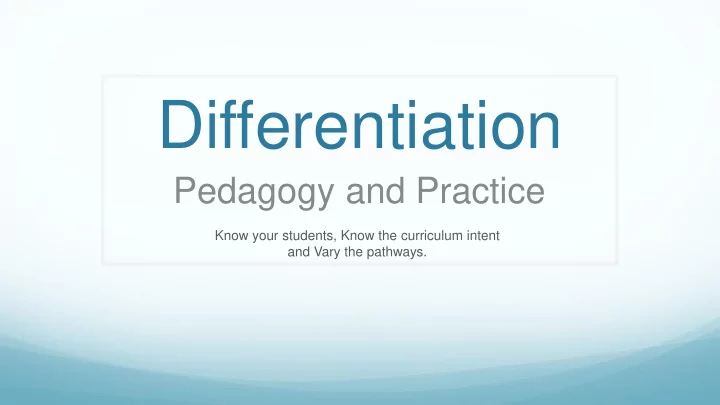

Differentiation Pedagogy and Practice Know your students, Know the curriculum intent and Vary the pathways.
Our Journey Following recommendations from the School Audit of the school carried out in 2011, Differentiation was highlighted as an area for improvement within the school. Also from the School Audit, Reading Comprehension was identified as a key learning priority and would serve as the school’s focus for differentiation practices. 3 staff members were selected for Gifted Education Mentor (GEMs) training in 2011 with the vision of differentiation becoming a school focus. This training for staff has been ongoing and to date in 2015, we have 23 staff members trained as GEMs. In 2012, a shared understanding of differentiation was formulated by the staff. Professional Development (PD) ‘One Size Doesn’t Fit All’ was delivered to the staff and a Differentiation Placemat was introduced as a tool to assist teachers in planning for all learners.
Documentation of differentiation in our planning led to the development of a WESS Differentiation Codes Placemat. The Placemat was trialled and modified over 12 months based on feedback from and consultation with the staff. DIFFERENTIATION CODES PLACEMAT Code Code Code Code CONTENT PROCESS PRODUCT ENVIRONMENT C1 Inquiry based learning PC1 Varied pedagogy/ instructional strategies PD1 Focus on individual goals in class. E.g. E1 Provide a Home / school communication book. communication, language, social skills C2 Individualized goals and modified content and PC2 Break tasks down into simple steps PD2 Modified assessment tasks and constraints E2 Flexible class seating arrangements or skills learning spaces C3 Extend language and concepts PC3 Cater for learning styles/multiple intelligences. PD3 Allow verbal / pictorial response instead of E3 Varied computer programs, AV, time written allotments C4 Plan for generalizations/ links to real life PC4 Implement additional support: e.g. fine motor, PD4 Negotiated tasks/criteria, /taskvariety or choices E4 Provide self-assessment opportunities behaviour, phonics. C5 Simplify language/ pre-teach key vocabulary PC5 Repeat, rephrase, model, highlight language, PD5 Provide alternative assessment opportunities E5 Risk Management Plan/ Health Management allocate extra time, . Plan/ Behaviour Management Plan current C6 Research projects PC6 Six thinking hats PD6 Monitor data to provide program feedback. E6 Learning contracts/learning centres C7 Tiered tasks PC7 Activity choice PD7 Independent study E7 Peer support Program C8 Provide individual support PC8 Hot skills PD8 Learning log E8 Involvement of specialist teachers, AVO, GO, SLP, OT, EAL, STLN, Counsellor support C9 Modify quantity or complexity of work: e.g. no of PC9 Modify worksheets and learning resources, PD9 Group investigation E9 Monitor lunchtime activities to support spelling words, questions, length of presentation, visuals, print, complexity of visual texts, interaction, safety, explicit teaching of skills writing expectations. interest level. and positive social interactions. C10 Fast track curriculum PC10 Provide graphic organizers E10 Flexible grouping C11 Pre-Assessments PC11 Small Group Targeted Support E11 Streaming Provide diverse range of learning resources – C12 Student profiling PC12 E12 Use visual aides / pictorial directions concrete, visual
Journey Continued A staff survey was conducted in 2013 and revealed a need for further investigation into specific differentiation strategies and ways to cater for students working above the year level standard. PD was provided to all staff to address these needs. Smart Goals were introduced and used throughout the school for individualizing student goals. In 2014 pre-assessment PD was delivered as a starting point for differentiated planning. Teachers worked in year level teams to design a pre-assessment task for the first English unit. Later in that year the teams provided feedback to the whole staff as to the success/effectiveness of that pre-assessment task. Differentiation was embedded into the school Guided Reading Program.
In 2015 the Coaching and Mentoring Team are providing teachers in each year level with Feedback For Learning (F4L) PD. The focus is on unit planning, building on staff’s prior knowledge of pre - assessment, the design of activities for children working above and below year level standard, formative and summative assessment. The differentiation team created the WESS Curriculum Assessment Overview. This overview shows the range of assessment opportunities given throughout a year and from year to year, ensuring a balance of different assessment modes.
Example of Pre-assessment and Differentiation in Year 3 Pre-assessment of a task allows teachers to differentiate and modify a summative assessment for individual learners. Above standard: Older audience, longer retell, complexity of language and text structure This provides all students with a supportive and targeted approach to completing assessment to the best of their ability. Below standard: Younger audience, shorter retell, familiar language and simpler structure
Examples of what differentiation in Reading looks like in year one: Reading Groups • PM Benchmark • Reading Goals • Reading strategies
Data recorded from PM Benchmarking
Reading goal data collection
Writing Each child is given an individual goal based on data collected through pre assessment, summative assessment and observation. Goal achievement is awarded and recorded on our goal tree.
English Pre-test Data – Year 4
Questions …. ?
Recommend
More recommend